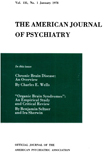THE AUTISTIC CHILD IN ADOLESCENCE
Abstract
Sixty-three autistic children have been reevaluated at a mean age of 15 years after a mean follow-up period of 9 years. Almost one third have achieved at least a moderate social adjustment. The prognosis has been shown to vary significantly with the presence of useful speech at the age of 5, taken as an index of the severity of autistic isolation. Half of those who possessed meaningful language by the age of 5 improved, whereas only 1 of 31 without the ability to communicate verbally by that age has shown significant improvement. The clinical course of these children justifies the segregation of early infantile autism as a clinical entity, probably to be included within the group of schizophrenias. The psychopathology of autism has been reviewed and the suggestion offered that the fundamental feature is a disturbance in social perception.
Access content
To read the fulltext, please use one of the options below to sign in or purchase access.- Personal login
- Institutional Login
- Sign in via OpenAthens
- Register for access
-
Please login/register if you wish to pair your device and check access availability.
Not a subscriber?
PsychiatryOnline subscription options offer access to the DSM-5 library, books, journals, CME, and patient resources. This all-in-one virtual library provides psychiatrists and mental health professionals with key resources for diagnosis, treatment, research, and professional development.
Need more help? PsychiatryOnline Customer Service may be reached by emailing [email protected] or by calling 800-368-5777 (in the U.S.) or 703-907-7322 (outside the U.S.).



